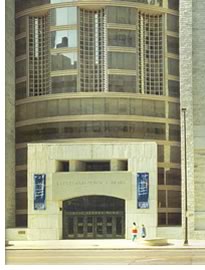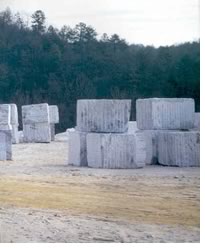
From Stone Work: Designing with Stone by Malcolm Holzman, FAIA
 "To
use stone effectively today requires research about the material. This
is an exploratory and analytic activity. Selecting a specific stone, determining
appropriate finishes, evaluating methods of erecting, and assessing potential
design ideas commence with understanding the resources available at the
quarry. Stone's fabrication and the architecture that results have changed
just as stone has evolved from a product of nature to one of commerce.
But even in this new millennium, as fabricators and suppliers adjust to
an expanding global economy, both the manufacture of stone products and
the practice of architecture retain elements of their cottage-industry
origins. Devotion to craft, work performed by groups of similarly inclined
people, modest return on initial investment, and a personal vision are
still at the heart of these two endeavors.
"To
use stone effectively today requires research about the material. This
is an exploratory and analytic activity. Selecting a specific stone, determining
appropriate finishes, evaluating methods of erecting, and assessing potential
design ideas commence with understanding the resources available at the
quarry. Stone's fabrication and the architecture that results have changed
just as stone has evolved from a product of nature to one of commerce.
But even in this new millennium, as fabricators and suppliers adjust to
an expanding global economy, both the manufacture of stone products and
the practice of architecture retain elements of their cottage-industry
origins. Devotion to craft, work performed by groups of similarly inclined
people, modest return on initial investment, and a personal vision are
still at the heart of these two endeavors.
 "Each
stone contains traces of its evolution. The quarry is where its potential
as a building material can be fully appreciated. Here, one can best determine
whether to apply it in conventional or uncommon ways, and whether the
finished results will be ordinary or aspire to the lyrical. I derive as
much information from quarry visits as from any other factor affecting
design . . .
"Each
stone contains traces of its evolution. The quarry is where its potential
as a building material can be fully appreciated. Here, one can best determine
whether to apply it in conventional or uncommon ways, and whether the
finished results will be ordinary or aspire to the lyrical. I derive as
much information from quarry visits as from any other factor affecting
design . . .
"In expectation of matching stone for the Cleveland Public Library's new Louis Stokes Wing to that of its 1928 predecessor, I visited its source, the century-old quarry in Tate, Georgia. Because the stone had been extracted continuously from the same quarry pit for 70 years, there was uncertainty about finding comparable material. While a match was the intended purpose of the visit, it was not difficult to witness other aspects of this operation.
 "During
tours of their pits, fabrication shops, and stored marble, I observed
a vast array of quarry blocks that had been produced prior to the introduction
of saws. The drills used to extract those blocks were so tightly and regularly
spaced that the resulting parallel grooves made their exterior surfaces
seem fluted. The entry portal to the new Louis Stokes Wing of the library,
assembled from the drilled outer surfaces of the quarry blocks makes a
visual reference to the fluted columns of its neo-classical predecessor.
At the time of the original quarry visit, my intention was to determine
if a color and veining 'match' could be made after so many years of operation.
Not only did this prove possible, but I also discovered the flutes that
suggest a second link between the new construction and the existing historic
structure."
"During
tours of their pits, fabrication shops, and stored marble, I observed
a vast array of quarry blocks that had been produced prior to the introduction
of saws. The drills used to extract those blocks were so tightly and regularly
spaced that the resulting parallel grooves made their exterior surfaces
seem fluted. The entry portal to the new Louis Stokes Wing of the library,
assembled from the drilled outer surfaces of the quarry blocks makes a
visual reference to the fluted columns of its neo-classical predecessor.
At the time of the original quarry visit, my intention was to determine
if a color and veining 'match' could be made after so many years of operation.
Not only did this prove possible, but I also discovered the flutes that
suggest a second link between the new construction and the existing historic
structure."
Copyright 2002 The American Institute of Architects. All rights reserved.
![]()
|
Read a review of Stone Work. To purchase a copy of Stone Work from the AIA Bookstore ($54 AIA members/$60 nonmembers) phone 800-242-3837, option #4, fax 202-626-7519, or email. The 2002 National AIA Convention and Expo, May 9 to 11 in Charlotte, features a Stone and Tile Pavilion, sponsored by Stone World and Contemporary Stone & Tile Design magazines. The pavilion shows the latest products and services in the stone and tile industry. Click for complete convention information. The International Exhibition of Marble, Stone and Technology, MARMOMACC, will be in Verona, Italy, October 3–6, 2002. Host Veronafiere, with cosponsors Stone World, and Italian Trade Commission, will be sponsoring 15 AIA members again this year for its course, "The Use of Marble and Stone Materials in Modern Architecture." The course includes field trips to a quarry and granite factory, seminars, and other site visits. Applicants are responsible for their own airfare and a $250 fee to cover local expenses partially. Candidates will be accepted based on their demonstrated interest in the field, responsibilities within their firm, and experience with stone projects. The deadline for applications is July 12, 2002. The two-day core program of two days qualifies for 9 AIA/CES learning-unit hours. The complete course runs an additional two days and carries 18 learning-unit hours. All learning-unit hours meet HSW criteria. Fax a curriculum vitae and cover letter on why you wish to participate in the course and the number of days you will attend to 202-393-4655 or send email. |
|